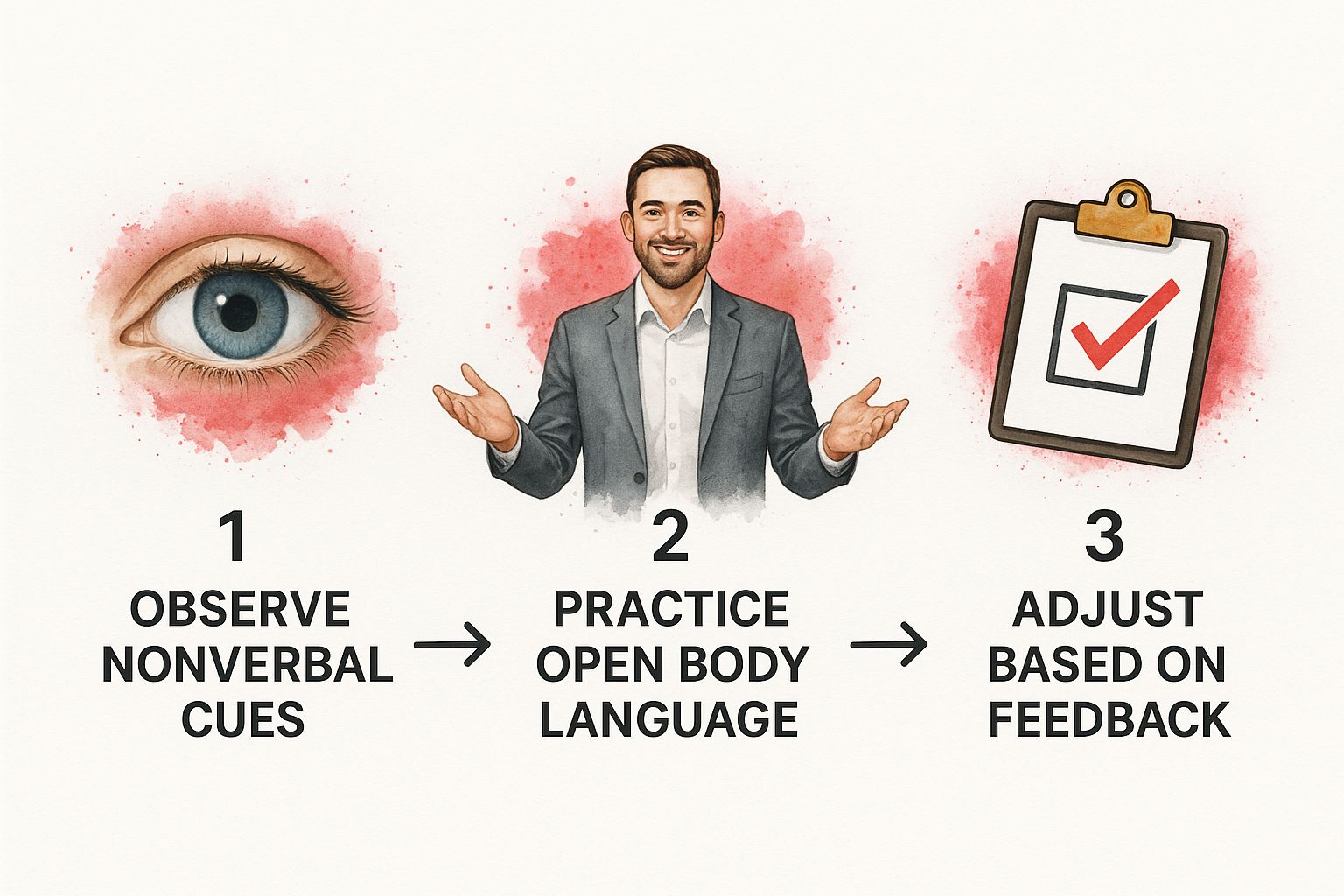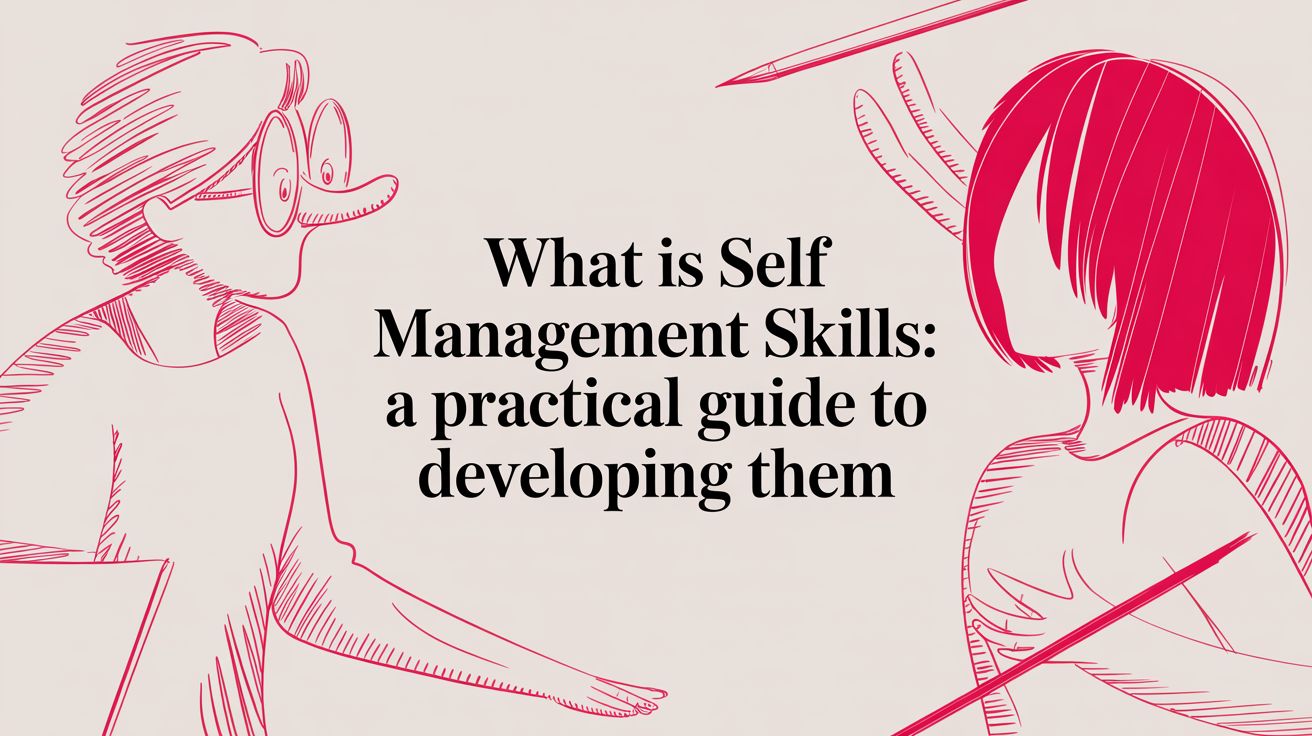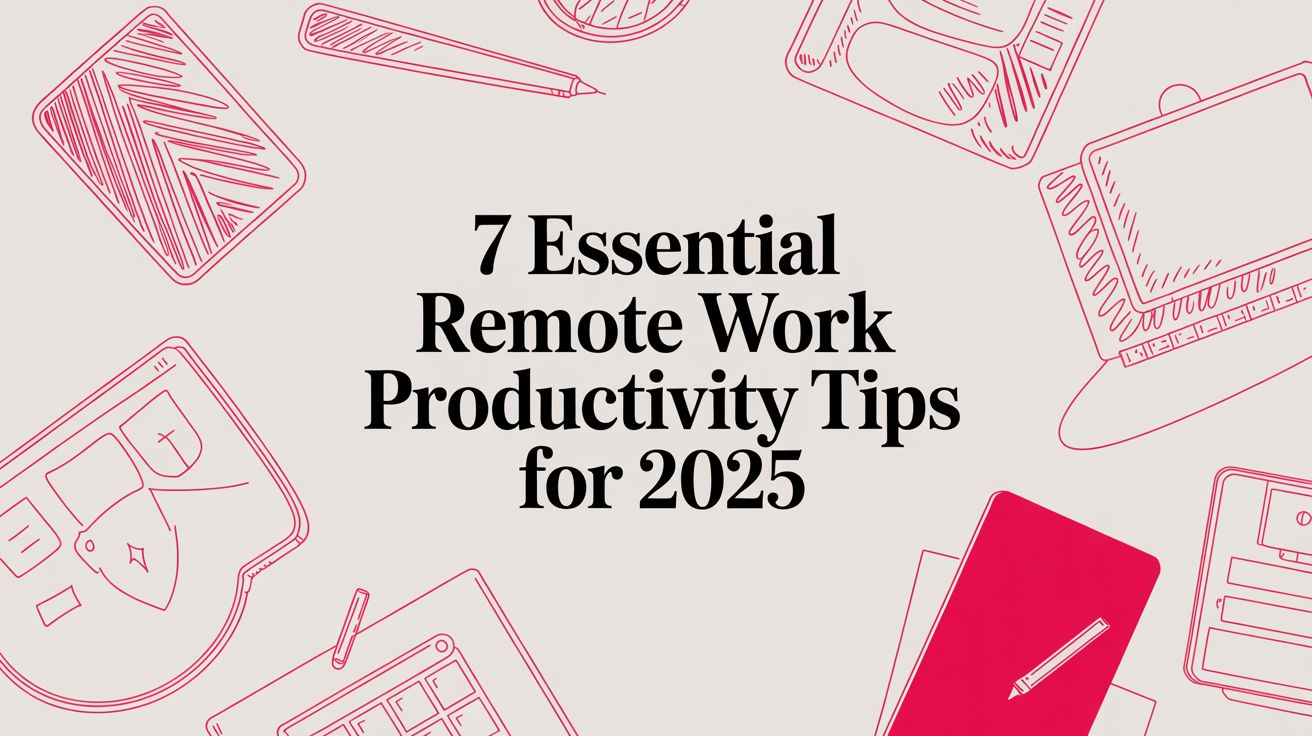How to Improve Communication Skills at Work
Max
If you want to get ahead at work, you need to be a great communicator. But what does that even mean? It’s not just about being well-spoken. It’s about mastering three core skills: genuinely hearing what others are saying (active listening), getting your own point across without confusion (clear articulation), and navigating the world of remote tools with ease (digital fluency).
This guide isn’t about vague advice. It’s a practical roadmap to help you become more influential and effective, starting today.
Why Effective Communication Is Your Career Superpower

It’s tempting to write off “good communication” as a fuzzy soft skill—something to check off on a performance review. But in reality, the ability to connect, persuade, and truly understand one another is the engine that drives careers and makes teams click.
Think about it. Bad communication isn’t just about an awkward meeting or a rambling email. It’s the root cause of missed deadlines, failed projects, and a team that just feels… off. It’s the invisible friction that grinds progress to a halt and slowly erodes trust.
On the flip side, workplaces that nail communication see incredible results. When people are on the same page and feel safe enough to share their real thoughts, that’s when the magic happens. Ideas flow, feedback becomes a gift instead of a criticism, and collaboration feels effortless.
The Undeniable Link Between Communication and Performance
The numbers don’t lie. Great communication isn’t just a “nice-to-have”; it’s a hard business metric. The data consistently shows a direct line between how well people communicate and how successful they are.
In fact, a jaw-dropping 86% of employees and executives blame a lack of effective communication for failures in the workplace.
This skill is so critical that 57% of employers worldwide say it’s the single most important skill they look for in new hires. And for good reason—teams that communicate exceptionally well can see their productivity jump by as much as 25%. You can dig into more of these communication stats on pumble.com.
The biggest mistake we make is confusing talking with communicating. Real communication is a two-way street. It requires listening to understand, not just waiting for your turn to speak. Getting this right is what separates the good professionals from the truly great ones.
Before we dive into the “how,” let’s set the stage with the key skills we’ll be covering. This table breaks down the core pillars of communication and shows exactly why they matter for your professional growth.
Core Communication Pillars for Professional Growth
| Communication Pillar | Its Impact on Your Work | Key Professional Outcome |
|---|---|---|
| Active Listening | You build stronger relationships and prevent costly misunderstandings by truly hearing what your colleagues need and mean. | Increased trust, fewer errors, and stronger team cohesion. |
| Clear Articulation | Your ideas get noticed and acted upon because you can present them logically and persuasively, whether in writing or in person. | Greater influence, more effective presentations, and clearer project direction. |
| Digital Fluency | You collaborate seamlessly with your team, no matter where they are, by choosing the right tool and tone for every situation. | Improved remote productivity, stronger virtual teamwork, and enhanced professional presence online. |
This framework gives you a clear path forward. Now, let’s get into the specifics of building these skills.
The Pillars of Workplace Communication
Improving how you communicate isn’t about faking a new personality. It’s about building a practical toolkit you can rely on every day. We’re going to focus on three fundamental areas that will give you the biggest bang for your buck in terms of career growth and team impact.
Active Listening: This is way more than just staying quiet while someone else talks. It’s about absorbing the full message—the words, the tone, and the non-verbal cues (even over a video call!). The goal is to confirm you’ve understood correctly, nipping misunderstandings in the bud.
Clear Articulation: This is the art of getting your thoughts out of your head and into someone else’s, cleanly and simply. Whether you’re giving a major presentation or just firing off a quick Slack message, clarity ensures your point lands and gets the action it deserves.
Digital and Remote Fluency: With hybrid and remote work now the norm, you have to be a pro at communicating across different platforms. This means knowing when to send an email versus starting a video call and being extra intentional with your words to make up for the lack of in-person context.
Mastering Active Listening and Empathy
When people want to get better at workplace communication, they usually focus on talking. How can I be more persuasive? How can I sound more confident? But the real game-changer isn’t about talking—it’s about listening.
I’m not just talking about being quiet while someone else speaks. I mean truly active listening. It’s about absorbing the entire message, not just the words, to build trust, make your colleagues feel valued, and, frankly, prevent a lot of costly mistakes. You’re listening for tone, for hesitation, and sometimes, for what’s not being said at all.
The Power of the Playback Method
One of the simplest yet most powerful tools I’ve seen in my career is something I call the Playback Method. After someone gives you instructions or floats an idea, you simply repeat it back to them in your own words.
This isn’t just mindless parroting. It’s a gut-check. It shows you were paying attention and gives the other person a chance to catch any misunderstanding before it snowballs.
Think about this common scenario:
- Your Manager: “I need you to pull the Q3 sales data and highlight any accounts with more than a 15% drop.”
- Your Playback: “Okay, just so I’m clear—you want the raw Q3 sales numbers, and you specifically want me to flag any clients whose revenue fell by 15% or more compared to Q2?”
That quick confirmation takes maybe 10 seconds. But it can save you hours of redoing work and solidifies your reputation as someone who is reliable and detail-oriented.
Asking Clarifying Questions to Uncover the Real Issues
We’ve all been there. A colleague DMs you, “Can you take a look at this draft?” or “I need some help on the new project.” These kinds of vague requests are black holes of ambiguity.
Don’t be afraid to dig a little deeper to figure out what they really need. Asking smart, targeted questions isn’t being difficult; it’s being effective.
Instead of just saying “Sure,” try asking:
- “When you say ‘take a look,’ are you looking for feedback on grammar, the overall concept, or the structure?”
- “Happy to help with the project. What’s the most impactful thing I could tackle for you right now?”
- “What does success look like for this task? And what’s our deadline?”
Asking these questions ensures your efforts actually hit the mark. It also helps you document what’s needed, which is a critical skill in itself. If you want to get better at that, check out these tips on how to take better meeting notes to make sure nothing falls through the cracks.
Reading the Room, Even on a Video Call
A huge amount of communication is non-verbal. It’s easy to think we lose all of that when we’re working remotely, but that’s not entirely true. Even on a video call, there are plenty of cues to pick up on if you know what to look for.
You’ve probably heard the stat that 93% of communication is non-verbal. While the exact number is debated, the point stands: tone of voice, facial expressions, and posture are massive parts of the message.

This is a constant feedback loop. You observe, you adjust your own body language, and you adapt based on how the other person reacts.
Keep an eye out for these signals on your next call:
- Facial Expressions: Do they look confused? Engaged? Or are their eyes darting around the screen, clearly distracted?
- Tone of Voice: Is their voice energetic and upbeat, or is it flat and stressed?
- Posture: Are they leaning into the camera (a classic sign of engagement) or slouched back in their chair (a sign of disinterest)?
This is even more critical in a remote setup where it’s so easy to feel disconnected. For a deeper dive, our guide on remote work best practices has some great strategies for building stronger connections with your virtual team. At the end of the day, everything comes back to listening and empathy—they’re the bedrock of great communication.
Articulating Your Ideas with Clarity and Impact

Having a brilliant idea is one thing. Being able to share it so that it resonates, inspires action, and leaves no room for confusion? That’s a completely different ballgame. It’s the moment where many professionals stumble, but the good news is that structuring your thoughts is a skill you can absolutely build.
Learning to articulate your ideas is a cornerstone of effective communication in any workplace. It’s what transforms you from a quiet observer into an influential contributor whose voice gets heard—and respected.
Structure Your Thoughts for Live Conversations
Picture this: you’re in a team meeting, and the conversation lands on a topic you’re passionate about. When your moment comes, do you find yourself rambling, or do you deliver a sharp, persuasive point? Having a simple framework in your back pocket can make all the difference.
One of the most powerful tools I’ve ever used is the PREP Method. It’s a dead-simple, four-part structure that helps you make a compelling case quickly and confidently.
- P - Point: Kick things off with your main point or conclusion. No beating around the bush.
- R - Reason: Immediately follow up with the primary reason behind your point.
- E - Example: Back it up with a specific example, story, or piece of data.
- P - Point: Circle back and restate your main point to really drive it home.
Let’s see it in action. Imagine you want to convince your team to adopt a new project management tool.
Instead of a vague, “I think we should look at new software, there are lots of options and our current one is clunky,” you use PREP:
(Point) “I believe we should switch to the new project management tool, ProjectFlow.” (Reason) “My main reason is that it will dramatically cut down the time we waste on manual status updates.” (Example) “For instance, on the Miller account last month, our team spent a combined 15 hours just compiling update reports. ProjectFlow completely automates this with its real-time dashboards.” (Point) “That’s why I’m convinced switching to ProjectFlow is the right move for our team’s productivity.”
See the difference? This approach is direct, logical, and incredibly easy for your audience to follow. It keeps you from getting lost in the weeds and ensures your core message lands with some serious punch.
Crafting Written Messages That Get a Response
In our increasingly remote and hybrid world, your writing is often your first—and sometimes only—impression. A poorly worded email or a confusing Slack message can grind projects to a halt, create unnecessary friction, and ding your professional reputation. The goal is to write messages that are so clear they’re impossible to misunderstand.
When you’re putting ideas into writing, whether for a quick message or a full-blown presentation, techniques like writing effective headlines can make a huge difference in how your message is received.
Here’s a quick before-and-after of a pretty typical project update email:
Before (Confusing and Vague): Subject: Project Update “Hey team, just wanted to check in on the project. I looked at the draft and I have some thoughts. Can you get back to me when you can? Thanks.”
This email is a mess. It creates more questions than it answers. Which team? What project? What draft? What are the thoughts?!
After (Clear and Actionable): Subject: Feedback on Q4 Marketing Proposal Draft “Hi Sarah, I’ve reviewed the Q4 marketing proposal—great work. I have two specific suggestions for the budget section on page 4.
Could you please:
- Double-check the ad spend figures against the latest forecast?
- Add a line item for influencer collaborations?
Let me know if you can have these updates done by EOD tomorrow so we can get this finalized. Thanks for all your hard work on this!”
This version nails it. It’s specific, it names the recipient, provides context, lists clear action items, and sets a deadline. It respects the reader’s time and all but guarantees a fast, accurate response. These principles are vital for any team, which is why we cover them in our guide on the best practices for remote teams.
By mastering frameworks like PREP for speaking and adopting a clear, action-oriented approach to writing, you build a reputation as a thoughtful and effective communicator—a massive step in your career growth.
Navigating Digital and Remote Communication
In any modern job, knowing how to improve communication skills at work really means you have to get good at digital communication. It’s a completely different ballgame. When you can’t see someone’s body language or hear their tone, the words you type on a screen suddenly carry all the weight.
Every Slack message, email, or video call is a chance to either create crystal-clear understanding or a whole lot of confusion. The trick is to be intentional. You have to be more deliberate and explicit than you would in a face-to-face chat, because what seems obvious in an office can easily get lost in translation online.
Choosing the Right Channel for Your Message
Let’s be honest—not all digital tools are created equal. Using the wrong one is the fastest way to annoy your team. We’ve all been there: getting a frantic Slack message about a complex, non-urgent issue that spikes your stress, or getting a formal email for a simple question that could’ve been answered in ten seconds.
Developing a mental checklist for which channel to use is a game-changer. Here’s a simple way I think about it:
- Instant Messaging (Slack, Teams): Think of this as a virtual tap on the shoulder. It’s perfect for quick, informal questions, hashing something out in real-time, or sharing a funny GIF to boost team morale.
- Email: This is your go-to for anything that needs a paper trail. Use it for formal announcements, detailed project updates that need to go to several people, or documenting important decisions so you can refer back to them later.
- Video Calls (Zoom, Google Meet): When you need that human element, jump on a video call. This is non-negotiable for sensitive conversations, deep brainstorming sessions, or any team-building where seeing faces actually matters.
A classic mistake is defaulting to the fastest channel instead of the clearest one. Before you fire off a message, just ask yourself: “Does this need an answer right now, or does it need a thoughtful, documented response?” That one question can save everyone a ton of headaches.
Overcoming the Lack of Non-Verbal Cues
When you’re communicating from behind a screen, you’re missing a huge piece of the puzzle: non-verbal cues. All the context you get from body language, facial expressions, and tone of voice is gone. To make up for it, you have to spell things out. Ambiguity is your worst enemy.
Don’t just write, “Can you look this over?” That’s a recipe for confusion.
Instead, try something much more specific: “Could you please review the attached proposal? I’m specifically looking for your feedback on the budget section. Let me know if you see any red flags by EOD.”
See the difference? This approach leaves zero room for guesswork. Your colleague knows exactly what you need, why you need it, and when it’s due. It’s always better to be a little too clear than to be misunderstood.
Leveraging AI to Enhance Workplace Communication
The modern communication toolkit has a new superstar: AI assistants. These aren’t just some futuristic idea anymore; they’re practical tools that can sharpen your writing, save you time, and cut down on mistakes. In fact, a whopping 73% of knowledge workers say generative AI tools have helped reduce misunderstandings at work.
The data backs this up. While 55% of people still rely on email to talk to clients and 11% use online chat, AI is surging. With 73% of companies already using or planning to use AI chatbots, getting comfortable with these tools is no longer optional. You can dig into more of these trends in these workplace communication statistics from notta.ai.
Here are a few practical ways AI can be your new best friend at work:
- Summarizing Meetings: Got a long meeting transcript? Pop it into an AI tool and ask for a concise summary with clear action items. It ensures everyone is on the same page, even if they zoned out for a bit.
- Improving Clarity: Wrote a clunky email? Paste it into an AI writer and ask it to “make this message clearer and more professional.”
- Refining Tone: Worried your feedback sounds a little harsh? Ask an AI assistant to “rewrite this with a more collaborative and positive tone.”
By being smart about the channels you pick, intentionally clear in your writing, and open to using modern tools, you can become a communication pro in any digital workplace. You’ll build a stronger, more connected team, no matter where everyone is located.
How to Give and Receive Feedback Effectively

Let’s talk about feedback. It’s one of the most powerful—and most mishandled—tools we have for career growth. The ability to both give and receive it gracefully is a game-changer for your communication skills. Done right, feedback builds trust and boosts performance. Done wrong, it just creates defensiveness and kills motivation.
The goal is to stop seeing feedback as something to dread and start seeing it as fuel for your development. This takes a structured, empathetic approach, whether you’re the one giving the critique or the one on the receiving end.
Giving Feedback That Is Actionable, Not Personal
The secret to giving great feedback is to strip away personal judgment and focus entirely on objective, observable behaviors. One of the best frameworks I’ve ever used for this is the Situation-Behavior-Impact (SBI) model. It’s a simple but incredibly effective way to keep the conversation productive.
The SBI model forces you to be specific, which helps the other person understand the real-world consequences of their actions without feeling attacked. This is how you build a foundation of trust, which is especially vital when you’re not in the same room. For more on this, our article on building trust in virtual teams has some fantastic strategies.
So, how does SBI work in practice? Let’s use a common scenario, like a missed deadline.
- Situation: First, you set the scene. Get specific about the when and where. You might start with, “During yesterday’s team meeting…”
- Behavior: Next, describe the specific, observable action. No assumptions, no judgment. Simply state what happened: “You mentioned the report would be ready by EOD, but it wasn’t delivered.”
- Impact: Finally, explain the effect this behavior had on you, the team, or the project. For instance, “This meant the marketing team couldn’t start their part of the project, which puts our launch date at risk.”
See the difference? This approach is direct and factual. You aren’t saying, “You’re unreliable.” You’re saying, “This specific action caused this specific problem.” It immediately opens the door for a collaborative solution instead of putting someone on the defensive.
Receiving Feedback Without Getting Defensive
Now for the other side of the coin, which is often the hardest part—being on the receiving end. It’s completely natural to feel a sting of criticism, but how you react determines everything. Your reaction can either turn the feedback into a tool for growth or a source of resentment. The mission here is to listen to understand, not just to fire back a response.
When you receive feedback, your first instinct might be to explain why something happened. Resist that urge. Your immediate job is to listen and absorb. Thank the person for sharing their perspective, even if it’s tough to hear.
This single act shows maturity and a genuine commitment to improving. Once you’ve truly listened, you can start turning that critique into a concrete action plan.
Here are a few practical strategies to handle feedback like a pro:
- Ask Clarifying Questions: “Thanks for sharing that. Can you give me a specific example of when this happened so I can better understand?”
- Summarize to Confirm: “So what I’m hearing is that when I don’t provide a clear agenda for meetings, it makes it hard for the team to prepare. Is that right?”
- Commit to Action: “This is really helpful. I’m going to work on sending out a pre-read agenda at least 24 hours before our weekly syncs.”
When you approach feedback with this kind of structure and emotional intelligence, you completely change the dynamic. It stops being a dreaded conversation and becomes one of the most valuable exchanges you can have at work.
Putting It All into Practice
Alright, let’s talk about making all this stick. Knowing how to communicate better is one thing, but actually doing it is a whole different ballgame. Real improvement doesn’t come from just reading about it; it comes from weaving these techniques into your daily grind until they become second nature.
The secret? Don’t try to boil the ocean. If you try to change everything at once, you’ll burn out. Instead, pick one thing. Seriously, just one.
Maybe this week, you focus on the “Playback Method” in every single meeting. Next week, your goal could be to write every project update with crystal-clear, numbered action items. Small, consistent efforts build powerful habits.
Create Your Pre-Conversation Checklist
To make this even easier, get into the habit of a quick pre-game huddle with yourself before any important conversation. Whether you’re gearing up for a tough feedback session, a big presentation, or even just a critical email, a simple checklist can be your best friend.
It helps you walk in with confidence instead of just winging it.
- What’s my one key message? If they remember nothing else, what’s the one thing I need them to walk away with?
- Who am I talking to? What do they actually care about? Frame your message for them, not for you.
- What does a “win” look like? Define the ideal outcome before you even start.
- What landmines might be out there? Think about the questions or pushback you might get and prepare your thoughts ahead of time.
Sticking with new habits takes real discipline, and it’s even tougher when you’re working from home and the couch is calling your name. If you feel your focus slipping, it’s worth checking out some tips on how to stay motivated working from home to keep your professional growth on track.
Solicit Feedback and Track Your Progress
You can’t get better if you don’t know where you’re falling short. This part can feel a little awkward at first, but it’s crucial: start asking for feedback.
Don’t just ask, “How am I doing?” That’s too vague. Get specific. Pull a trusted colleague or your manager aside and ask things like, “Hey, in that meeting, was my point about the budget clear?” or “How could I have explained that design concept more effectively?”
I also recommend keeping a simple journal. Just a few notes on which techniques you tried and how they landed. Did that email with bolded key takeaways get a faster response? Did summarizing the action items at the end of the call prevent confusion later? This isn’t for anyone else—it’s for you. It builds self-awareness and helps you see what’s working.
Remember, your individual growth has a ripple effect. When you get better, the whole team benefits. It’s a great idea to explore some strategies to improve team communication and see how your efforts can lift everyone up. This is how you stop talking about improving and actually start doing it.
Common Workplace Communication Questions
Even with the best game plan, some situations at work can just throw you for a loop. Getting better at workplace communication isn’t just about strategy; it’s about knowing how to handle those tricky, real-world moments as they pop up.
This section tackles some of the most common questions I hear, with direct, no-fluff answers to help you navigate these challenges with confidence. These aren’t just hypotheticals—they’re the daily hurdles that can make or break your professional relationships and your career. Let’s get into it.
How Can I Improve My Communication as an Introvert
This is a fantastic question because it completely flips the script on what “good communication” really means. It’s not about being the loudest person in the room. It’s about being the most effective. For introverts, this is a huge advantage.
You need to focus on your natural strengths. Introverts are often exceptional listeners and deliberate thinkers. So, instead of trying to force yourself to be more outspoken, lean into those skills. A great practical tip is to prepare for meetings by jotting down your key points beforehand. This lets you contribute thoughtfully without that on-the-spot pressure.
Your superpower is depth over volume. While others are quick to speak, you have the ability to process information and offer a more considered, insightful perspective. Lean into that.
Also, use written channels like email or Slack to your advantage. These platforms give you the space to articulate complex ideas with a level of precision that can be tough to nail in a fast-paced verbal discussion.
How Do I Deal with a Poor Communicator at Work
It can be incredibly frustrating trying to work with someone who’s a poor communicator. It derails projects and creates endless confusion. The best approach? Lead by example and proactively build the clarity you wish you were getting from them.
Start by always communicating with them in the clear, concise way you want them to communicate with you. When you make requests, use simple bullet points or a numbered list and always include firm deadlines. This models the exact behavior you’re looking for.
I highly recommend using the Playback Method to confirm you’ve understood their vague requests. A quick, “Just to confirm, you need the final report by EOD Friday, focusing only on the Q3 data?” can save you hours of rework. It’s a lifesaver.
If the problem keeps happening, a gentle, private conversation using the SBI model is your next move.
- Situation: “When project updates are sent without specific deadlines…”
- Impact: “…it’s difficult for me to prioritize my tasks effectively.”
- Behavior (as a question): “Could we make sure to include delivery dates moving forward?”
This keeps the focus on the process, not the person. It feels like a collaborative request, not a confrontation.
What Is the Best Way to Talk About Career Goals with My Manager
Bringing up your career ambitions can feel awkward, but it’s absolutely essential for your growth. The secret is to frame the conversation around how you can add more value to the team, not just what you want for yourself.
First off, schedule a dedicated “career development” meeting. Don’t try to tack this on at the end of a regular weekly sync-up. Giving it its own time slot signals that it’s an important, forward-looking conversation.
Kick things off by affirming your commitment to your current role, then pivot to your future goals. You could say something like, “I’m really enjoying my work on the marketing team, and I’m eager to continue growing here. I’m particularly interested in taking on more responsibility in areas like project leadership. What skills do you think I should focus on developing to get there?”
This approach turns your manager into a partner in your growth, making them much more invested in helping you succeed. It shows proactive ambition, not pushy entitlement.
How Do I Avoid Misunderstandings with a Remote Team
In a remote setting, ambiguity is the enemy. You don’t have body language or tone to rely on, so you have to prioritize extreme clarity and solid documentation to keep everyone on the same page.
The very first step is to establish team-wide “communication norms.” This is just a simple document that outlines which tool to use for which purpose (e.g., Slack for quick questions, email for formal updates). Remember, over-communicating is always better than under-communicating. To foster a strong sense of connection and clarity, explore how to build a great remote work culture within your team.
Another non-negotiable habit: always create a written summary of key decisions and action items from video calls. Post this recap in a shared channel. That way, there’s a single source of truth no one can argue with.
Ready to find a role where your communication skills will be valued? Remote First Jobs connects talented professionals like you with top-tier companies offering genuine remote opportunities. Stop scrolling through spam and start browsing thousands of verified, remote-first positions today at https://remotefirstjobs.com.


